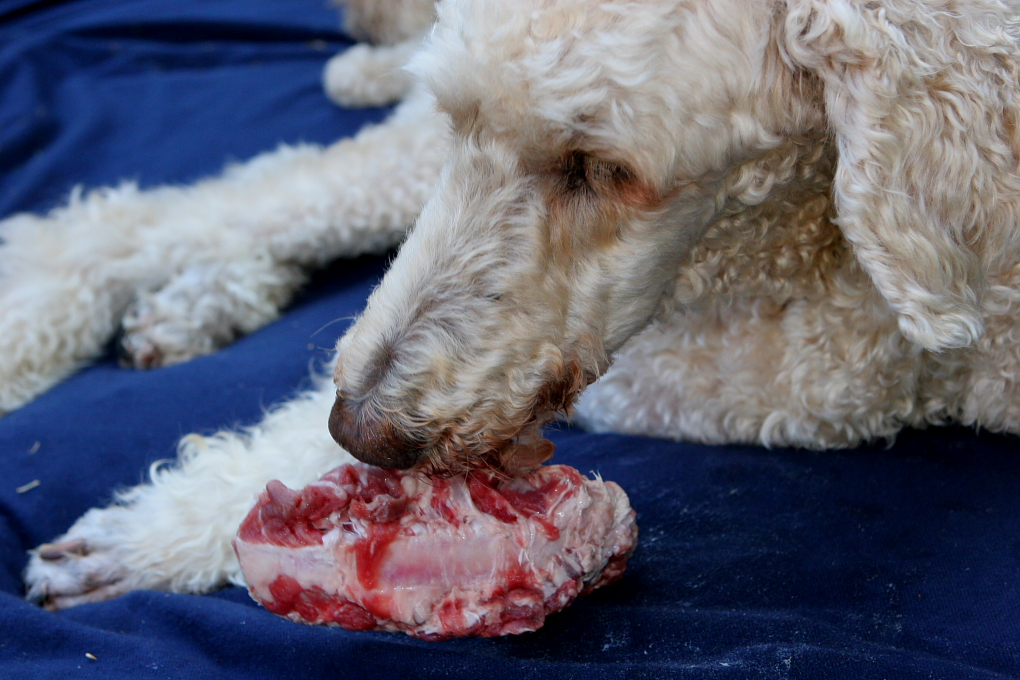
As an avid weight lifter I know the importance of protein for muscle growth. The other day I wondered what the actual numbers were for protein as far as dog are concerned. What I found after much research is that there is no easy answer. Much of the information out there is for protein in dog food which is measured by a percentage. Whereas our protein requirements are measured in grams. Measuring protein by percentage is assuming that all proteins are alike. So I dug deeper.
Much of what goes into dog food is unusable by our dog's bodies. Of course the better the food you choose the better the ingredients. But how do you know what is a good food and what is not? Well, like I wrote yesterday, I'd stay away from the big guys first. Next read the ingredient label. This may sound easy but it is not. Here is a great article on how to read the ingredient label.
Reading the label
What I found after much reading was that dogs generally need 2 grams of high biologic protein per kg of body weight. (Merck Veterinary Manual) High biologic protein refers to animal protein that can be used nutritionally. Beaks, hooves and hair contain protein but are very low as far as usability. They are not utilized well as they are digested. They contain less value for a dog nutritionally.
Trying to figure out the actual high biologic amount of protein in dog food is a difficult task. There is the list of ingredients to decipher, moist content, actual protein ingredient to attempt to figure out and more. Whereas the amount of protein you give to a dog fed in it's real form is a much easier task. That said, most people feed dog food so when you do; do your research. Do not take the percentage rates on the bag as a whole truth, dig.
protein chart
Our bodies need protein to build and maintain muscle. Of course there are other things involved as well, like exercise and other nutrients. But protein is a big part of building muscle. The more one exercises the more protein they require. But even in quality proteins, they are not all alike. The chart listed above will let you know what contains the most percentage per weight.
The dog food project This is a great link if you want to delve further. About amino acids, protein etc.
I could go on and on and get very scientific but I prefer to leave that to those who want to do the research. I have listed several good links but there are more, you just have to dig. There is much more to nutrition and muscle growth than just protein but protein is a big part. Are we shorting our dogs? I think much of the time. Muscle will not grow without proper fuel and exercise, they go hand in hand. We have been duped for far too long as far as feeding our dogs. Time to look into it and see what you come up with.
We eat what we eat and don't think much of it correct? Yet when it comes to our dogs we must read the labels and try to figure out what is really in the bag. Keep it simple, the fewer ingredients the better, just like your own food. The big companies who are spending literally millions on advertising campaigns are not spending it on quality ingredients. Next time you see a big ad on television for a new dog food or human food for that matter, think.

AuntSue
ReplyDeleteI adopted a standard rat terrier this summer, she was so fat, she looked and felt like a couch cushion (27.6 lbs). She was 7 years old, and hadn't been walked in years because "she pulled". She was being fed Beneful (cornmeal). After a month of 3 short walks daily (on a Halti, lamb and rice kibble, lots of time in the yard making tunnels under the shrubs, she looks like a dog. Her coat is shiny, her tooth tartar is falling off in chunks (Dentastix as bedtime treat), she has tons of energy and is having way more fun.